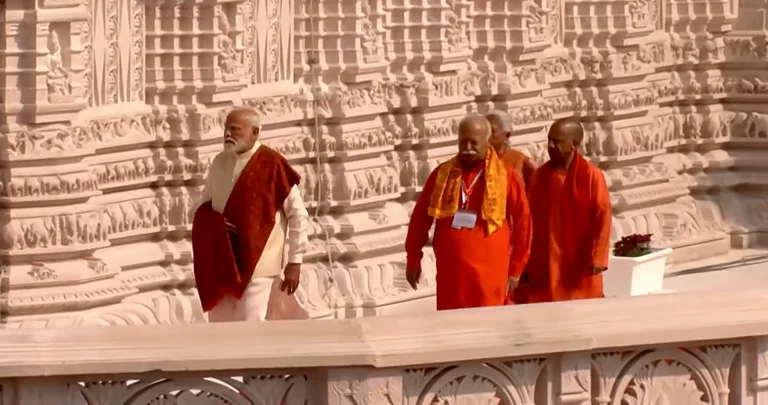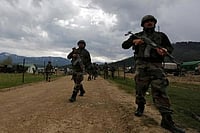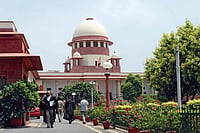As BJP leader Lal Krishna Advani’s three-decade-old dream of building the Ram Mandir is realised, he won't be present today to see it come to life at the grand consecration ceremony in Ayodhya. The 96-year-old BJP veteran has decided not to attend the Prana Pratishta ceremony due to extreme cold weather. There had been much sketicism surrounding his attendance at the event with the Shri Ram Janmbhoomi Teerth Kshetra trust previously indicating that Advani and Murli Manohar Joshi were unlikely to attend due to health and age concerns.
The BJP stalwart renowned for spearheading the Ram Janmabhoomi campaign in 1990, recently acknowledged his role as merely the "charioteer of the Ram Rath Yatra" in an interview with a Hindi magazine Rashtra Dharma. He said it was the Prime Minister Narendra Modi, the "anannya bhakt" (unwavering devotee), who had been entrusted with the consecration of the Ram Mandir.
As the nation gears up for the grand inauguration of the Ram Mandir in Ayodhya, Outlook looks back at the role of LK Advani in the political movement. Once the prominent face of the Ram Janmabhoomi movement, Advani played a pivotal role in shaping the course of events that led to the realisation of BJP's longstanding ambition of constructing the Ram Mandir.
Who is Lal Krishna Advani?
Lal Krishna Advani, born on November 8, 1927, in pre-Partition Sindh, has played a pivotal role in shaping the political landscape of India. After graduating from the D.G. National College in Hyderabad, Advani studied law at the Government Law College in Bombay.
At the age of 14, he joined the Rashtriya Swayamsevak Sangh (RSS) in 1942. Forced to migrate to Delhi after Partition, Advani became an RSS pracharak in Rajasthan. His political journey continued as he joined the Bharatiya Jana Sangh, the predecessor of the Bharatiya Janata Party (BJP), when it was formed in 1951.
Advani's association with the BJP began at its inception in 1980, where he, alongside Atal Bihari Vajpayee, played a crucial role in establishing and strengthening the party. Serving as the longest-serving president of the BJP, Advani was instrumental in popularising the party and making it one of the strongest political forces in India.
Advani emerged as the face of the BJP's assertive Hindutva ideology, leading the party's surge in the 1990s. Alongside Vajpayee, he played a key role in the BJP's transformation, marking a significant shift in Indian politics during the 1996 elections when the BJP became the largest party in the Lok Sabha, displacing the Congress from its dominant position for the first time since independence.
In 1990, Advani led a significant journey called the rath yatra, which ended with his arrest in Bihar. This journey not only gained a lot of support but also set the stage for the destruction of the Babri Masjid and widespread riots.
LK Advani’s Ram Rath Yatra
In the 1990s, L.K. Advani became the leading face of the Ram Janmabhoomi movement, initiating the Ram Rath Yatra on September 25, 1990. The yatra aimed to garner support for building a Ram temple in Ayodhya. Covering 10,000 km, the journey stirred significant political and social tensions as massive crowds gathered during the chariot procession across various states.
Advani's mission with the rath yatra was to reshape history and narrate north Indian folklore from a strong Hindutva perspective. His speeches aimed to instil sentiments against the Babri Masjid among Hindus, portraying it as a symbol of Babur's 'invasion'.
The slogan, “Saugandh Ram ki khate hain; hum mandir wahin banayegein”, gained popularity during LK Advani’s rath yatra and was used extensively by the Hindutva groups.
Bihar Chief Minister Lalu Prasad temporarily halted the rallies by arresting Advani in September 1990. However, just before the 1991 elections, Advani resumed his yatras in Bihar and Uttar Pradesh, ostensibly for his party's campaign. Despite this, he focused solely on advocating for the construction of the Ram temple in Ayodhya and did not seek votes or appeal to the electorate on behalf of his party.
Speaking to Hindi magazine Rashtra Dharma, Advani referred to the “Ram Rath Yatra” which he took out 33 years ago “as the most decisive and transformative event in his political journey”, which allowed him to “rediscover India and, in the process, reconnect with himself”.


























